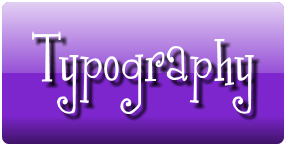
Typography is the manipulation of text on a page consisting of fonts, font styles (bold, italics and underlined), font sizes, colors and faces, such as Times New Roman, Helvetica, Arial, etc. typography also include ordered lists, unordered lists, definition lists, and bulleted lists.
Typography is important for the presentation of your web site. Being creative with fonts, font styles and font styles can really make your web site stand out from the others.
When creating a web site, it is important to remember to use the proper XHTML element. Using the proper elements will ensure that your pages are XHTML compliant and that you will separate the structure of your pages from its presentation.
The tag has been left behind for the use of the cascading style sheet. All elements for fonts, font sizes, and font style can be contained in the cascading style sheet, which is one page that links formatting to all web pages. If you defined the font information on every page with the tag, you could potentially have to make hundreds of changes on a web site. That is why all font characteristics are now defined in the Cascading Style Sheet.
Below are the questions and answers to the "In Review" on Page 71 of EWD:
Times New Roman, Georgia, Courier, Serif, Arial, Verdana, Helvetica, Geneva, Sand serif, and Corsiva.
This tag allows you to control the fonts on your site by placing it in the body of your document: <font face="Verdana, Arial, Helvetica, sans serif">Now enter all of your text between these two tags!</font>
Georgia and Verdana provide good spacing between the characters so that each letter is distinct and easily readable.
A font family is a group of variations on a single font. An example of a font family is Arial, Arial Bold, Arial Black, Arial Narrow, and Arial Italic.
x-height: The standard for the height of the lowercase letters.
baseline: The line that the base, or the bottom, of the letters are aligned on.
ascenders: The parts of a font that go above the x-height line such as the letters b, d, f, h, k, and l.
descenders: The parts of a font that hang below the baseline such as the letters y, g, p, and q.
leading: The vertical space between two line of type which can be used to create interesting logos for a company.
kerning: The space between individual letters.
tracking: The spacing between all letters in a line.
scale: Resets the length and width of the font.
Serif fonts have tails at the end of the strokes.
This is serif font.
San-serif fonts have no tails at the end of the strokes.
This is a sans-serif font.